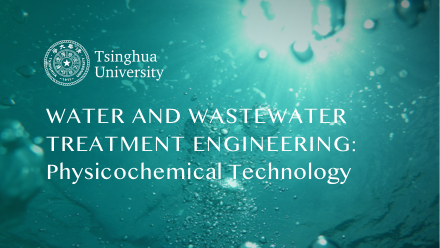
当前课程知识点:Water and Wastewater Treatment Engineering: Physicochemical Technology > Chapter 5 Disinfection > 5-2 Influence factors of disinfection > 5-2 Influence factors of disinfection
返回《Water and Wastewater Treatment Engineering: Physicochemical Technology》慕课在线视频课程列表
返回《Water and Wastewater Treatment Engineering: Physicochemical Technology》慕课在线视频列表
同学们好,在这一节我们将介绍消毒的影响因素
消毒过程中的主要影响因素包括接触时间、消毒剂浓度、温度等
首先我们介绍接触时间的影响
1908年Chick就发现在一定消毒剂的浓度下
微生物浓度的减少速度与微生物浓度呈线性关系
由此得到了Chick定律的微分方程式
这里Nt是某一个时刻的微生物浓度,k是灭活速率常数,t是反应时间
对这个式子进行积分,我们就可以得到微生物浓度与时间的指数关系
或者也可以以常用对数或自然对数的方式进行表述
这个定律表明接触时间越长,细菌的杀灭效率就越高
那么公式中的灭活速率常数该如何确定呢?
这两个半对数形式的公式表明,在一定的消毒剂浓度下
在半对数坐标上,灭活率的对数与时间呈线性关系
由此,我们可以根据试验数据,得到灭活率和时间的线性关系
然后由斜率计算出灭活速率常数k
然而,在实际的消毒过程中,通常会偏离上述线性关系
即消毒曲线出现滞后或者拖尾的现象
如这图所示,左边表示的是消毒曲线滞后的现象
主要是由于水中的其他组分比微生物先与消毒剂发生反应
因此使得消毒曲线滞后
而右边表示的消毒曲线的拖尾现象
则是由于部分微生物以聚集体形式存在或被包埋在胶体或颗粒物中
影响了与消毒剂的接触和反应,造成消毒曲线滞后
此外,研究还发现灭活速率常数k与消毒剂的浓度有关
即与消毒剂浓度C的n次方呈正比
将灭活速率常数与消毒剂浓度的关系带入到微生物灭活速率的计算式中
我们就得到了Chick-Watson 定律
这个式子表示微生物的灭活速率
与消毒剂浓度的n次方以及某一时刻残存的微生物浓度Nt成正比
进一步积分得到指数形式的公式
也可以以对数形式表示,如以下两个公式所示
这里有一个重要的参数,就是C的n次方乘以t
当灭活率一定时,C^nt值为常数。那么,其中的n如何求解呢?
我们对这个式子两边取对数,在双对数坐标上
消毒剂浓度C和接触时间t呈线性关系,由斜率就可以求出n值
那么这个n究竟有什么物理意义呢?
如果n等于1,说明消毒剂浓度和接触时间对消毒效果有同等影响
如果n大于1,表明消毒剂浓度影响更大
如果n小于1,表明接触时间影响更大
一般情况下,n值约为1,因此可以把n作为1来进行考虑
由此得到C和t的乘积,即CT值,我们称之为浓时积
这里的C为剩余消毒剂浓度,t为接触时间,以t10
即清水池的90%保证率接触时间来计算
这个t10,我们将在后面进行介绍
该式的物理意义为,对于一定的灭活率要求
消毒剂的浓度和接触时间的乘积是一个常数
CT值是消毒工艺中一个非常重要的指标
它可以作为消毒剂消毒能力的一个重要的判断指标来评价消毒效果
消毒剂种类、微生物、水温和pH条件不同时
达到一定灭活要求的CT值也是不同的
在同样条件下,如果达到一定灭活率所需要的CT值越小
说明消毒剂的消毒能力就越大
这里我们以贾第鞭毛虫为例进行说明
当贾第鞭毛虫的灭活率要求达到99.9%时
游离氯、二氧化氯、臭氧以及氯胺4种消毒剂
在温度分别为5℃、10℃和20℃条件下的CT值如表所示
可以看到,臭氧的CT值最低,其次是二氧化氯
再其次是游离氯,而氯胺的CT值是最高的
说明臭氧的消毒能力最强,而氯胺的消毒能力在这4种消毒剂中是最弱的
前面我们介绍过,在CT值的计算中
接触时间t应为清水池的90%保证率接触时间t10
我们下面来看看为什么会有这个规定呢?
在给水处理厂,消毒剂一般投加在清水池前
利用清水池来满足消毒剂与水的接触时间
但是在清水池中,水流不能达到理想的推流状态
部分水流的停留时间小于平均停留时间
在清水池设计中,我们一般要求消毒接触时间的保证率大于90%
即要保证90%以上的水流在清水池中的停留时间
能够满足CT值对消毒接触时间的要求
因此,在消毒计算中
校核CT值的消毒接触时间应采用90%保证率的接触时间,即t10
而不是清水池名义上的水力停留时间
那么,这个t10怎么获得呢?
这是一个示踪实验
时间t等于0时,在清水池的进水口处瞬时投加示踪剂
然后在清水池出口处连续检测示踪剂浓度
绘制出口处示踪剂浓度的变化曲线和累积示踪剂流出量的变化曲线,如这个图所示
对应10%累积示踪剂流出量的停留时间
就是该清水池的90%保证率的接触时间t10
由于清水池存在短流、死区等现象,t10要远小于名义水力停留时间
清水池的t10与名义水力停留时间T之间的关系可以用下面的公式表示
其中V为清水池容积;Q为流量;β为有效系数
对于内部设有多道导流墙,推流状态比较好的清水池
β的取值一般较高,在0.65-0.85之间
而对于没有导流墙或只有1-2个导流墙的清水池
β值在0.5以下,推流状态不好
短流现象严重,将会导致消毒效果不好
可以看到,清水池的设计和水力条件对消毒效果影响很大
如果要提高消毒效果,可以改善清水池的推流状态。那么,如何改善呢?
我们可以在清水池中,增加导流墙,减少短流,以提高β值
这样就可以在同样的消毒剂投加量和清水池容积的条件下
通过提高t10,实现更大的CT值,从而获得更好的消毒效果
下面,我们来具体分析一下CT值的提高如何影响消毒效果
CT值与微生物对数去除的关系可以用下面这个式子来表示
对于同一种微生物,采用不同CT值时
其CT值之比就等于微生物的对数去除之比
很显然,CT值提高后,微生物对数去除率提高
微生物浓度去除率也相应提高
下面介绍温度对消毒效果的影响
温度对消毒速率的影响可以用阿伦尼乌斯公式来进行描述,如这个公式所示
其中k1,k2分别表示温度T1,T2条件下的灭活速度常数
R是气体常数,E是消毒反应的活化能
根据这个公式我们就可以推测出温度对消毒效果的影响
一般是温度越高,消毒速率常数越大,也就是说消毒效果越好
这一节,我们介绍了消毒的主要影响因素
下一节,我们将介绍最常用的氯消毒的应用情况
下节再见!
-0-2 Water treatment process
-0-3 Wastewater treatment process
--0-3 Wastewater treatment process
-Chap 0 Homeworks
-1-1 Introduction
-1-2 Properties of colloids
-1-3 Mechanisms and process of coagulation and flocculation
--1-3 Mechanisms of coagulation and flocculation
-1-4 Coagulant and coagulant aids
-- 1-4 Coagulant and coagulant aids
-1-5 Kinetics of coagulation and flocculation
--1-5 Kinetics of coagulation and flocculation
-1-6 Factors affecting the coagulation performance
--1-6 Factors affecting the coagulation performance
-1-7 Facilities for coagulation and flocculation
--1-7 Facilities for coagulation and flocculation
-Chapter 1 Homeworks
-2-1 Introduction
-2-2 Discrete particle settling
--2-2 Discrete particle settling
-2-3 Flocculent settling
-2-4 Zone settling
-2-5 Rectangular settling tank
--2-5 Rectangular settling tanks
-2-6 Process calculation of rectangular settling tanks
--2-6 Process calculation of rectangular settling tanks
-2-7 Vertical Flow (up-flow ) and radial flow settling tank
--2-7 Vertical Flow (up-flow ) and radial flow settling tank
-2-8 Plated sedimentation tank
--2-8 Plated sedimentation tank
-2-9 Clarification pool
-3D interactive demonstration for settling tanks
-Chapter 2 Homework (part 1)
-Chapter 2 Homework (part 2)
-3-1 Introduction
-3-2 Theoretical foundation of air floatation
--3-2 Theoretical foundation of air floatation
-3-3 Pressurized dissolved air flotation
--3-3 Pressurized dissolved air flotation
-Chapter 3 Homework
-4-1 Introduction
-4-2 Structure and process of conventional rapid filter
--4-2 Structure and process of conventional rapid filter
-4-3 Water head loss of filter
--4-3 Water head loss of filter
-4-4 Filtration method of filter
--4-4 Filtration method of filter
-4-5 Filter media
-4-6 Water distribution system
--4-6 Water distribution system
-4-7 Filter backwashing
-4-8 Siphon filter
-4-9 Gravity valveless filter
--4-9 Gravity valveless filter
-4-10 Movable hood filter
-3D interactive demonstration for filtration tanks
--Usage and description for 3-D demonstration
-Chapter 4 Homework
-5-1 Introduction
-5-2 Influence factors of disinfection
--5-2 Influence factors of disinfection
-5-3 Chlorine disinfection
-5-4 Chlorine dioxide disinfection
--5-4 Chlorine dioxide disinfection
-5-5 Ultraviolet disinfection
--5-5 Ultraviolet disinfection
-Chapter 5 Homework
-6-1 Ion-exchange resin
-6-2 Properties of ion-exchange reactions
--6-2 Properties of ion-exchange reactions
-6-3 Properties of cation exchange resin
--6-3 Properties of cation exchange resin
-6-4 Properties of anion exchange resin
--6-4 Properties of anion exchange resin
-6-5 Softening system using ion exchange
--6-5 Softening system using ion exchange
-6-6 Desalination system using ion exchange
--6-6 Desalination system using ion exchange
-6-7 Ion-exchange equipment
-6-8 Treatment of industrial wastewater by ion-exchange method
--6-8 Treatment of industrial wastewater by ion-exchange method
-Chapter 6 Homework
-7-1 Introduction
-7-2 Principle and characteristics of electrodialysis
--7-2 Principle and characteristics of electrodialysis
-7-3 Configuration of electrodialysis unit
--7-3 Configuration of electrodialysis unit
-7-4 Operating parameters for electrodialysis unit
--7-4 Operating parameters for electrodialysis unit
-7-5 Principle and process of reverse osmosis
--7-5 Principle and process of reverse osmosis
-7-6 Operating parameters for reverse osmosis
--7-6 Operating parameters for reverse osmosis
-7-7 Principles and characteristics of UF and MF
--7-7 Principles and characteristics of UF and MF
-7-8 Design of ultrafiltration and microfiltration process
--7-8 Design of ultrafiltration and microfiltration process
-Chapter 7 Homework
-8-1 Fundamental knowledge and classification
--8-1 Fundamental knowledge and classification
-8-2 Ozonation
-8-3 Photo-catalytic oxidation
--8-3 Photo-catalytic oxidation
-8-4 Supercritical water oxidation
--8-4 Supercritical water oxidation
-8-5 Electrolysis
-Chapter 8 Homework
-9-1 Introduction
-9-2 Adsorption equilibrium and adsorption isotherm
--9-2 Adsorption equilibrium and adsorption isotherm
-9-3 Adsorption breakthrough curve
--9-3 Adsorption breakthrough curve
-Chapter 9 Homework


